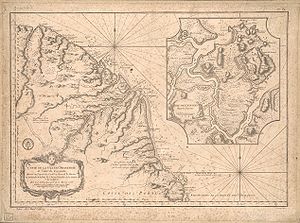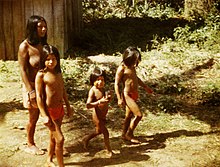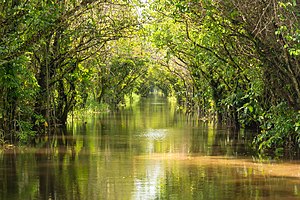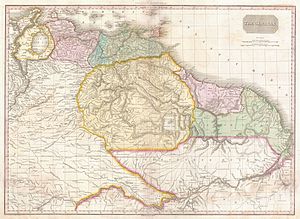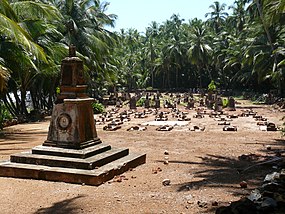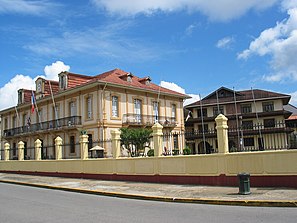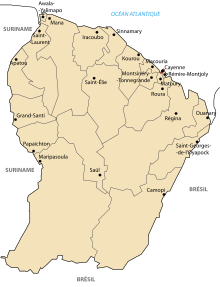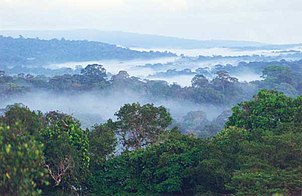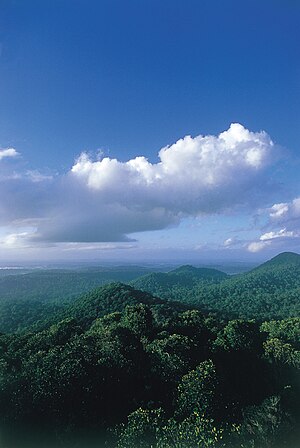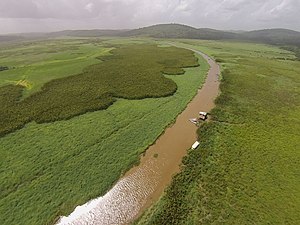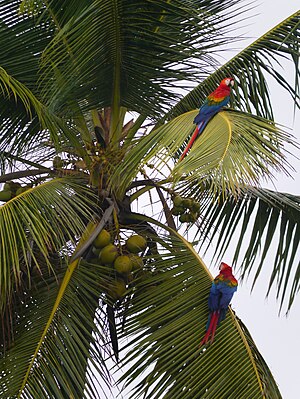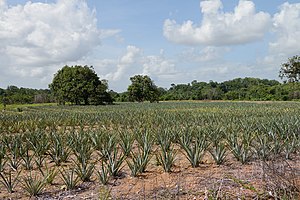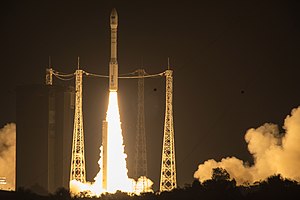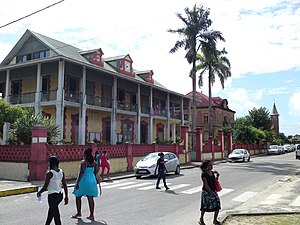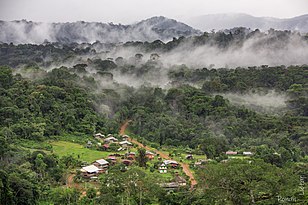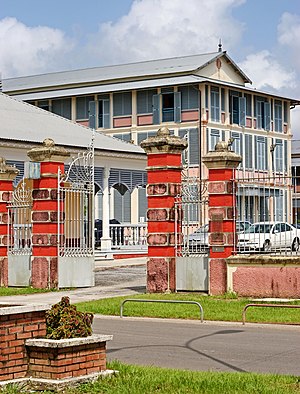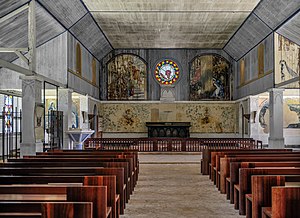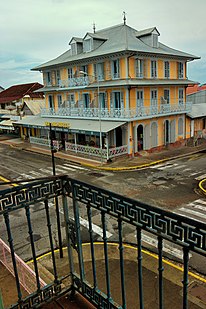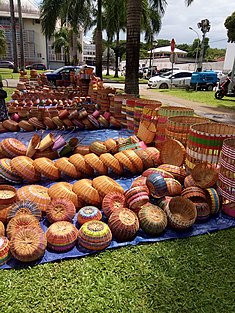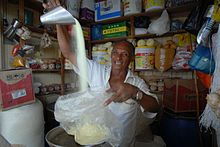French guiana
The French Guiana (in French, Guyane or Guyane française, pronounced /ɡɥijan fʁɑ̃sɛz/), is a region and overseas department of France, which is part of the European Union as the outermost region. As a unique territorial collectivity, it only consists of an assembly that regroups the powers of the regional and departmental Council. It is the only territory in continental South America that has chosen full integration into a European country. Therefore, it is not considered a country as such, unlike Guyana and Suriname, which did manage to achieve their independence.
It is located on the northern coast of South America, in the Guianas region, between Brazil and Suriname, bordering the Atlantic Ocean to the north. Its capital and most populous city is Cayenne.
Before European contact, the territory was originally inhabited by indigenous people from the Americas, most of whom spoke the Arawakan language. The first French settlement was recorded in 1503, but France did not establish a lasting presence until Cayenne was founded by colonists in 1643. French Guiana developed as a slave society with planters importing Africans in large numbers as slave laborers in large sugar factories and other plantations. The population increased that way. Slavery was abolished in the colonies at the time of the French Revolution. Guiana was designated a French department in 1797. But, after France abandoned its territory in North America, it developed Guiana as a penal colony, establishing a network of camps and penal centers along the coast where prisoners of metropolitan France were sentenced to forced labor.
During World War II and the fall of France to German forces, French-Guyanese Félix Éboué was one of the first to support General Charles de Gaulle of Free France, as early as June 18, 1940. Guyana French Guiana officially joined Free France in 1943. French Guiana gave up its colony status and once again became a French department in 1946. After de Gaulle was elected President of France, he established the Kourou Spaceport in 1965 It is now operated by the National Center for Space Studies, Arianespace and the European Space Agency (ESA).
In the late 1970s and early 1980s, several hundred Miao (Hmong) refugees from Laos immigrated to French Guiana, fleeing displacement after the United States' involvement in the Vietnam War. In the late 1980s, more than 10,000 Surinamese refugees, mostly Maroons, arrived in French Guiana, fleeing Suriname's civil war. More recently, French Guiana has received large numbers of Surinamese, Brazilian, and Haitian economic immigrants. Illegal and polluting gold mining by Brazilian garimpeiros is a chronic problem in the remote interior forest of French Guiana.
Fully integrated into the central French state in the 21st century, French Guiana is part of the European Union and its The official currency is the euro. A large part of Guyana's economy derives from jobs and businesses associated with the presence of the Kourou spaceport, which is now the main launch site for the European Space Agency near Earth's equator. As in other parts of France, the official language is standard French, but each ethnic community has its own language, of which French Creole, a French-based creole language, is the most widely spoken.
Etymology
Guiana comes from the Amerindian term land of many waters. The adjective French is incorporated in most languages other than French, because it sinks its roots in the colonial era in which there were five colonies called Las Guayanas. Namely, Spanish Guiana (Guiana Region, in Venezuela), British Guiana, Dutch Guiana, French Guiana and Portuguese Guiana (Brazilian region of Amapá).
History
French Guiana was originally inhabited by indigenous Carib and Arawak tribes primarily from Venezuela, and also by small groups of Galibi, Emerillon, Palikour, Waiampi and Wayana.
France colonized the territory in the 17th century; this colonization took place when Louis XIV sent thousands of colonists to Guyana. The colonists were seduced to carry out this enterprise with stories of great gold and easy fortunes to make. But instead they found a land filled with hostile natives and tropical diseases. A year and a half later, only a few hundred survived.
The survivors fled to three small islands that could be seen from the shoreline and named them the Îles du Salut (Islands of Salvation). When the survivors of this failed expedition returned home, the terrible stories they told of the colony left a lasting impression on France.
In 1794, after Robespierre's death, 193 of his followers were sent to Guyana. In 1797 the republican general Pichegru and many deputies and journalists were also sent to the colony. Later, slaves were brought from Africa and plantations were established along the disease-free zones along the rivers, which brought some prosperity to the colony for the first time. In December 1808 it was invaded by Portuguese-Brazilian troops due to the Napoleonic invasion in Portugal. In 1848, France abolished slavery and former slaves fled into the jungle, establishing communities similar to the ones they had when they lived in Africa before being captured.
In 1852, the first loads of chained convicts arrived from metropolitan France. In 1885, the French Third Republic to get rid of habitual criminals and increase the number of settlers, the French parliament passed a law that anyone, whether male or female, who had more than three sentences for theft of more than three months each, he would be sent to French Guiana as a relegated. These relegates were kept in prison there for a period of six months after which they were released to become inhabitants of the colony. However, this experiment was a failure: the prisoners were unable to earn a living working the land, so they were forced to reoffend or eke out a living to death. In fact, being sent to French Guiana as a relegate was a life sentence, and usually a short one, since most of the relegates died quickly of disease and malnutrition.
Amerindians and Europeans
The first archaeological remains (ceramics, rock carvings, polishers, etc.) of Amerindian peoples between the Oyapock and Maroni rivers date back to the 5th millennium BC. Many of his successors in the same geographic area belong mainly to the Tupi-Guarani language group.
It is estimated that at the end of the 2nd century, Arawak and Palikur Indians from the banks of the Amazon settled on the Guyanese coast. In the eighth century they were followed by the Kalinago or Karibes, the Kali'na (Galibis) and the Wayana.
The coast of Guyana was recognized by Christopher Columbus in 1498. Despite the division of the New World in 1494 by the Treaty of Tordesillas between Portugal and Spain, European nations made numerous attempts to colonize Guyana starting in the 19th century XVI.
In 1503 the first French settlements began in the Cayenne area, especially the French, through the journey of Nicolas Guimestre in 1539, followed by the Englishman Robert Baker (1562) and Gaspard de Sotelle (1568-1573), who established more than 120 Spanish families on the island of Cayenne.
From 1596 to 1598, the Englishmen John Ley and Lawrence Keymis, and the Dutchman Abraham Cabeliau carried out a precise geographical reconnaissance of the Guyanese coast. The true European settlements appeared mainly in the [[XVII century]]], through occasional occupations (a few years) from the mouths of the rivers, and were the work of France, England, and the Netherlands.
In 1604, the colony of Guiana was renamed Equinoctial France.
French colonization
Although the first major attempts at French colonization date back to the 1620s, they were often thwarted by internal dissension among colonists, poor human relations with Amerindians, and even harsh living conditions, in particularly with yellow fever. For their part, the Amerindian nations had to face a high mortality rate, due to the wars waged against the colonizers, but also to the action of the epidemics recently imported from Europe.
For a long time, the French king's control of French Guiana was regularly contested; only with the recapture of Cayenne in December 1676 by Admiral Jean d'Estrées did the French finally establish themselves. Even then, they only controlled the island of Cayenne and, intermittently, some military posts in the river estuaries. This weak human and military presence largely explains the extreme ease with which the Portuguese from Brazil seized the island of Cayenne during the Napoleonic Wars, an island that they occupied from 1809 to 1817.
The colonization of French Guiana was initially carried out by European workers, the engagés, also known as the thirty-six months because they were bound by a labor contract. three years to his master. This attempt, due to the lack of volunteers, was quickly replaced by slaves of African origin, which were used in the dwellings (farms) to grow colonial products: sugar, spices, chocolate and coffee.
As in the other French colonies, slavery was largely governed by the texts of the Black Code (1685). This housing society remained the dominant economic model in French Guiana until the second abolition of slavery in 1848. However, it did not bring any real development to French Guiana, which remained the poor and depopulated region of the French colonial empire in America. In 1713, during the Treaty of Utrecht, the French King Louis XIV, to limit local conflicts with the Portuguese colony of Brazil, laid the foundations of the border between Brazil and France.
The Kourou expedition, which began in 1763, was poorly prepared. It was carried out at the request of Choiseul and directed by the knight Étienne-François Turgot, Governor, Jean-Baptiste Thibault de Chanvalon, Mayor, and Antoine Brûletout de Prefontaine, Commander, with the aim of establishing a true colony of farmers of European origin in the savannahs of western Guiana. However, it was a resounding failure: almost all the surviving settlers fled from Guyana to the metropolis. Only German and Canadian settlers remained in French Guiana, settling permanently in Kourou, Sinnamary, Malmanoury, Corossony, and Iracoubo, where they founded an original (and mixed) society of French Guiana farmers.
French Guiana was occupied by the British from 1778 to 1783, and then from 1785 to 1788.
During the Revolution, it became for the first time (Collot d'Herbois and Billaud-Varenne), a place of political deportation; They followed him in 1798, when French Guiana was constituted as a department, the fruitful deportees and the refractory priests: Counamama and Sinnamary were the graveyard for most of them.
Abolition of slavery
Slavery was abolished in 1794 in all the colonies, before Napoleon I reestablished it in 1804. It was definitively abolished by the decree abolishing slavery on April 27, 1848, under the auspices of abolitionist Victor Schoelcher. The disappearance of slave labor meant the paralysis of the traditional colonial economy.
During the French Revolution, French Guiana was occupied by the Portuguese, who held Brazil, from 1809 to 1817: this period of occupation left its mark on Franco-Guiana Creole, which incorporated many Portuguese words into its vocabulary. Although the island was returned to the French, following the application of the Treaty of Vienna in 1815, the effective return of the French occurred in April 1817, when a governor was sent.
To compensate for the lack of manpower, but above all to rid the metropolis of republican political opponents and common law criminals, the Second Empire created prisons in French Guiana. They welcomed deportees, transported people, and also relegated prisoners until 1946. In the 1930s, Special Penitentiary Establishments, also known as Annamese prisons, were created in the Inini Territory (see Crique Anguille Camp). Populated by political opponents and Indochinese intellectuals, but also by petty criminals, thieves and pimps, these prisons will be a bitter failure.
Attempts to populate French Guiana with free workers of immigrant origin (Africa, India, United States, Madeira, etc.) were no longer sustainable.
Franco-Brazilian dispute
In 1713, the Treaties of Utrecht established a border between French and Portuguese territories in the Guiana Shield. A river was to serve as the border, but the treaty is not certain to which river it refers. In 1822, Brazil became independent. Several hundred square kilometers are disputed between France and Brazil. The disputed territory became a neutral territory, a haven for adventurers, escaped convicts, and abandoned slaves. At the end of the 19th century, the two countries agreed to resort to Swiss arbitration. Brazilian diplomacy was very involved in this arbitration, while France did not put much effort into the negotiations. The Swiss arbitration was handed down in 1900 in favor of Brazil, and the Oyapock River remained as the border between French Guiana and Brazil. The French were unable to establish themselves in the now Brazilian bank.
Gold Rush
In 1855 a gold deposit was discovered in eastern Guyana, on the Arataye, a tributary of the Approuague. In the west, gold was mined from the Inini River (Haut-Maroni). The beginning of the 20th century was marked by a gold rush, with 10,000 active miners, leading to often artificial local commerce, and the cessation of the last agricultural activities due to lack of labor.
The short-lived existence of the independent Republic of Guyana (Amapá, 1886-1891, later the Free State of Counani (1904-1912)) is linked to this gold rush.
Like Réunion, Guadeloupe and Martinique, French Guiana became a French overseas department in 1946. However, economic takeoff was difficult due to high production costs, small population, commercial dependency (imports) from France and the flagrant lack of the most basic infrastructure: roads, schools, health system, etc.
Prison
Saint-Laurent-du-Maroni, Cayenne and the Isles de la Salvation were deportation centers for those sentenced to forced labor from 1852 to 1946, by decision of Napoleon III. Captain Alfred Dreyfus was sent there in 1894.
French Guiana remained a French colony until March 19, 1946, when it gained overseas department status. France hoped that the detainees were also settlers. But this was a failure. The closure of the prison was achieved after the Second World War, after the publication of 27 articles by Albert Londres and under the impulse of Gaston Monnerville. In 1938, the last convoy of convicts headed for French Guiana, but it was not until 1945 that the Constituent Assembly decided to repatriate the survivors who wanted it (very few remained). The operation lasted eight years.
French Guiana was designated the French Overseas Department on March 19, 1946. Penal colonies, including Devil's Island, were formally closed in 1951. At first, only released prisoners who could afford the fare for their return passage to metropolitan France they were able to return home, and thus French Guiana suffered after the official closure of the prisons from the crime exercised by numerous released prisoners who led an aimless existence in the colony.
Space Base
Since 1954 there has been little economic growth. French Guiana is heavily dependent on food and fuel imports and the level of unemployment is chronically high.
In 1964, General de Gaulle decided to build a space base in French Guiana to replace the Saharan base located in Algeria, in Hammaguir. The department's position is privileged, near the equator and with a wide opening to the ocean. The Guiana Space Center, since the first Véronique rockets, has developed considerably over the years.
The European spaceport with launchers such as the Ariane 4 and Ariane 5, which are proving to be a real commercial success around the world, the Guiana Space Center is also developing the Vega Program, and a base has been built Soyuz launch in Sinnamary. In 2021, French Guiana will see the launch of the new Ariane 6 rocket, a project developed in 2014.
In 1982, decentralization laws came into effect and powers were transferred to local authorities, which became actors in the development of French Guiana.
Substantial development has been sparked by the establishment of a European Space Agency satellite launch base at the Centre Spatial Guyanais, Kourou in 1975. This has provided local employment for technicians, mainly from the metropolis, and the soldiers, who bring cash to the local economy.
Recent history
On October 29, 2010, the European company Arianespace launched a rocket with two communication satellites on board from the Kourou base. Takeoff took place at 21:51 UTC.
In late March 2017, French Guianas began a general strike and protests for more resources and infrastructure. On March 28, 2017, the largest demonstration in the history of French Guiana was held. The protests have been intensifying against the French government.
The 2017 social movement in French Guiana began in Kourou and spread throughout the French Guiana territory in the days that followed. Its origin is related to the insecurity and lack of infrastructure of which the inhabitants of this French overseas department claim to be victims. It caused the postponement of the launch of an Ariane launcher and the delay of the arrival of several satellites at the Guiana Space Center.
The situation was resolved with the Guyana agreement, signed on April 21, in which the Cazeneuve government finally released more than 1 billion euros to finance projects aimed at improving health care, security, the economy and the functioning of justice in the department.
Government and politics
The law of March 2, 1982 established the creation of the region in a territorial collectivity in full exercise.
Since 2016, it has a single assembly that brings together the powers of the regional and departmental Council.
It is represented at the national level by two deputies, a senator and an economic and social adviser. The State is represented by the prefect established in Cayenne and by the sub-prefect of Saint-Laurent-du-Maroni.
Legal status
French Guiana is an administrative region whose prefecture is Cayenne. Together with Guadeloupe and Martinique, located in the Antilles, it forms the French Departments of America (départements français d'Amérique or DFA).
French Guiana has elected a single assembly since the Guyanese people approved, in a referendum held on January 24, 2010, the merger of the regional council and the general council into a single assembly or single collectivity.
At the communal level, there are 22 municipalities headed by mayors. Some of these municipalities, such as Maripasoula and Camopi, have a larger area than the metropolitan departments. Also, some municipalities are subdivided into villages supervised by captains.
In addition, French Guiana is represented at the national level by two deputies (see constituencies) and two senators.
It is also the largest of the nine outermost regions of the European Union, of which it is an overseas region.
Since January 1, 2012, French Guiana once again has its own court of appeal, abolished in 1947, with its own prosecutor's office. From 1947 to 2012, the cases were heard by the Court of Appeal of Fort-de-France in Martinique, more than 2,000 km from Cayenne. The first president of this new court of appeal, Pierre Gouzenne, took office on January 1, 2012, previously president of the Avignon court of high instance. The prosecutor who took over this new prosecutor's office on January 1, 2012 was Raymond Morey, formerly Nancy's prosecutor.
There is also a completely autonomous administrative court. Although a specific administrative court already existed, it was initially composed of magistrates from Fort-de-France (as is the case today in Saint Pierre and Miquelon). However, the court gradually became autonomous with the assignment of one, and later two, magistrates in permanent residence. There are now four magistrates, including a president, so that the court is fully autonomous.
Administrative division
French Guiana is divided into two administrative divisions named after their capital cities:
- Cayena District
- Saint-Laurent-du-Maroni District
These districts are further divided into 22 communes:
- Awala-Yalimapo
- Mana
- Saint-Laurent-du-Maroni
- Apatou
- Grand-Santi
- Papaïchton
- Saül
- Maripasoula
- Camopi
- Saint-Georges-de-l'Oyapock
- Ouanary
- Régina
- Roura
- Saint-Heie
- Iracoubo
- Sinnamary
- Kourou
- Macouria
- Montsinéry-Tonnegrande
- Matoury
- Cayenne
- Remire-Montjoly
Politics
Three political trends share Guyanese political life. The two main political forces remain, as in the rest of France, the loyalist right, represented by Les Républicains, and the loyalist left, represented by the Guiana Socialist Party (PSG), the Guyana Democratic Forces (FDG), the Socialist Party (PS) and Guyane Écologie (GE).
However, this "loyal left" now faces strong competition from La France insoumise. Finally, the third political trend is the extreme left of independence, represented by the Movement for Decolonization and Social Emancipation (MDES) and the Walwari (PRG).
The France Insoumise movement is represented in Guyana by eight Action Groups (AG or GoA). Jean-Luc Mélenchon's first result in the 2017 presidential elections and the movement's support for Davy Rimane's candidacy in the partial legislative elections of March 2018 have allowed La France insoumise to position itself as a new force on the left in the region.
Defense
As of 1 October 2013, the commander of the armed forces in Guyana is Air Force Major General Philippe Adam. There are 2,300 military personnel.
These forces are mainly distributed in the following units:
- 3.♪ Foreign Infantry Regiment (3.♪ REI) in Kourou (External Law);
- 9. Marine Regiment (9th RIMa) in Cayenne, in La Madeleine
- the adapted military service regiment of the French Guiana located in Saint-Jean-du-Maroni, with a detachment in Cayena;
- the air force based at the 367 air base near Félix-Eboué airport;
- the French Navy based at the naval base of Dégrad des Cannes;
- a detachment of the Paris Fire Corps in Kourou, which guarantees the protection of the persons and goods of the Space Centre
Geography
Its territory occupies an area of 83,846 square kilometers, making it the second largest region in France after Nouvelle-Aquitaine. It is located in the northern part of South America and borders Suriname to the west and Brazil to the east and south.
A dense equatorial jungle covers 90% of its territory. The main means of access to the interior are the waterways and most of the communities can only be reached by motorboat.
Only 5% of the territory is inhabited by the 208,000 inhabitants (in 1999), 60% of whom are Creoles and a little more than 10% French from Europe. Only the 390 kilometer coastal strip is easily accessible, the rest of the territory is covered by a dense equatorial forest. The neighboring country Suriname currently claims the area between the Litani and Maruiní rivers. This territorial conflict is still unresolved.
Situation
French Guiana borders Brazil for 730 km and Suriname for 520 km, making Brazil the country with the longest land border with France (Suriname is sixth).
To the southwest, in the Itany-Marwini triangle, a 6,000-square-kilometre territory uninhabited and claimed by Suriname depends on French Guiana. It is practically not visited, except by some gold prospectors and the French military. The re-estimate of the area of French Guiana is not related to this border dispute, but to an error made by the former Colonial Geographic Survey, which had attributed 91,000 square kilometers to the territory due to an erroneous estimate of the latitude of the sources of the Oyapock. The error was corrected in the 1960s by IGN.
It has an equatorial climate and is essentially covered by a huge tropical forest lined with mangroves on the sea side, the Guiana jungle. The subsoil is formed by an ancient rocky shield, rich in laterite, poor and acidic, which forms a relief known as orange peel dotted with inselbergs and cut by river networks. The latter have been the main routes of circulation for centuries or millennia. They make up 7 river basins, 953 water masses and are fed from 2.5 to 4 m of annual rainfall.
Topography
The relief of French Guiana was formed from ancient bedrock fringed by a coastal plain. Most of the region is located at an altitude between 100 and 200 meters, a sign of a very old morphological and geomorphological evolution that gives rise to weak topographic contrasts.
Two main topographic regions can be distinguished:
the coastal plain or "lowlands" which extends for a few tens of kilometers from the maritime border. It represents some 450,000 hectares covered with swamps and savannahs. It is an alluvial plain, more or less floodable, with an altitude of less than 30 meters;
the highlands that develop in the Guyanese plateau and represent almost 95% of the territory. The absence of tectonic movements since the primary era and the significant erosion that it suffered sculpted various forms of relief, of which the most important and characteristic is a convex hill described as half orange, approximately circular, several tens of meters high for a diameter more than a kilometer These half oranges, present in great numbers, give the highlands the appearance of a sea of hills.
Geology
Guiana is situated on the Guiana Plateau, which formed on steep terrain that disappeared under the action of erosion, leaving only a few metamorphosed fragments in contact with granitic plutons. At present, there are two geological groups: the recent sedimentary formations and the Precambrian formations.
The absence of sedimentary cover, eroded over time, reveals Precambrian formations, each with its characteristic landform: "almond-shaped hills" for the Orapu schists, and a series of identical hills of the same height with convex slopes for the Guiana granite. In addition to the influence on forestry (stands, accessibility, etc.), geology explains the richness of various minerals (gold, bauxite, tantalite, etc.) that are the basis of mining activities in French Guiana, such as washing of gold.
- Islands
- Islands of SalvationÎles du Salut)
- Devil Island (Devil Island)I'm sorry.)
- Royal Island (Royale.)
- San José IslandSaint-Joseph)
- Mountains
- Monte Bellevue de l'Inini (851 m)
- Sommet Tabulaire (830 m)
- Macizo du Mitaraka (690 m)
- Monte Saint-MarcelMont Saint-Marcel637 m)
- Macizo Dékou-Dékou (580) m)
Hydrology
Rainfall is high in French Guiana. Rainfall is largely the result of condensation from evapotranspiration from rainforest trees.
It is naturally acidic (with a pH change that can evolve significantly between dry and wet seasons)
Climate
French Guiana has a humid equatorial climate; the average temperature is 25.5 °C. Annual precipitation is an average of 2,816 mm in Cayenne during the period 1981 - 2010, according to Meteo France records.
Cayenne has a wet season from December to July and a drier period during the rest of the year. The precipitations begin to diminish in July (155 mm), being the months of September and October the "dry months" (respectively 39 and 51 mm on average), to increase again in November (105 mm). The rainiest month is May, with an average rainfall of 518 mm.
The rainiest months are May and June.
Globally, French Guiana is one of the wettest regions in the world, with rainfall ranging from 2,000 mm to 4,000 mm annually, and in terms of water availability compared to water reserves it ranks third in the world after the island of Greenland and the state of Alaska.
| Month | Ene. | Feb. | Mar. | Open up. | May. | Jun. | Jul. | Ago. | Sep. | Oct. | Nov. | Dec. | Annual |
|---|---|---|---|---|---|---|---|---|---|---|---|---|---|
| Temp. max. abs. (°C) | 32 | 34 | 33 | 33 | 33 | 34 | 34 | 36 | 36 | 36 | 35 | 34 | 36 |
| Average temperature (°C) | 27 | 28 | 28 | 28 | 28 | 28 | 29 | 30 | 31 | 30 | 30 | 28 | 29 |
| Temp. medium (°C) | 23 | 23 | 23 | 23 | 23 | 23 | 23 | 22 | 22 | 22 | 22 | 23 | 23 |
| Temp. min. abs. (°C) | 19 | 20 | 19 | 18 | 20 | 21 | 20 | 20 | 21 | 20 | 20 | 20 | 19 |
| Rains (mm) | 431 | 423 | 432 | 480 | 590 | 457 | 274 | 144 | 32 | 42 | 122 | 317 | 3744 |
| Rainy days (≥ 0.1 mm) | 23 | 20 | 21 | 19 | 25 | 26 | 21 | 14 | 6 | 5 | 11 | 21 | 212 |
| Hours of sun | 142.6 | 116.0 | 136.4 | 129.0 | 136.4 | 171.0 | 207.7 | 232.5 | 261.0 | 266.6 | 234.0 | 192.2 | 2225.4 |
| Source No. 1: BBC Weather 4 September 2012 | |||||||||||||
| Source No. 2: climatetemp.info | |||||||||||||
Hydrography
The hydrography of the region is characterized by a dense network of periodically flooded wetlands or streams (often meandering and with banks of dense vegetation, interspersed with waterfalls or falls). The abundant rainfall, the structure of the terrain and the impermeability of the soil explain the density and configuration of this hydrographic network.
The great rivers, the Maroni, the Oyapock, the Approuaguele Mana and the Sinnamary, are the axes of penetration into the interior of the country. However, modern navigation is hampered by the presence of impassable jumps and rapids, in low water, without transhipment. The Petit-Saut dam has strongly modified the hydrography of part of the Sinnamary basin.
Biodiversity
This department is one of the richest in the world in biodiversity, both animal and plant.
Vegetation
Almost the entire surface of the Guyanese rainforest is primary forest with a very high level of biodiversity (one of the richest hot spots in the world), protected by a national park, created in 2007, and six nature reserves. The International Union for Conservation of Nature (IUCN) and the European Union (EU) recommend special protection efforts.
Following the 2007 Grenelle Environment Forum, the Grenelle II bill proposed (in 2009, and subject to modifications) the creation of a single entity in French Guiana tasked with contributing to the implementation of policies of knowledge and conservation of the Amazonian natural heritage (with competences in matters of fauna, flora, natural and semi-natural habitats on land, rivers and coasts, and functioning of ecosystems). It will contribute to the application of environmental policies carried out by the State and the territorial authorities and their groups. Article 64 of the bill also provides for a "mining orientation departmental plan" for French Guiana, which promotes mining that is compatible with the demands of preserving the environment.
The environment of the coastal strip is the one that, along RN1, has historically suffered the most changes, but a high level of artificialization has been observed at a local level along RN 2 and in the places where gold miners operate in western French Guiana.
Paradoxically, the rainforest of French Guiana has thrived on some of the poorest soils in the world in terms of nitrogen, potassium, phosphorus and organic matter. For this reason, and because this area has always served as a refuge for all its species during dry periods or terrestrial glaciation, this jungle is home to some of the richest and most fragile ecosystems in the world: very old primary tropical forests, mangroves, savannahs, inselbergs and numerous types of wetlands.
The acidity of the soil is also at the origin of the poor quality of Guyanese soils. It forces farmers to whitewash the fields, and has given rise to the traditional slash-and-burn method of agriculture: the ashes help raise the potential for hydrogen (pH), in addition to providing mineral salts.
However, it should be noted that deposits of terra preta (anthropogenic soils) have been discovered in the territory, especially near the border with Brazil. Agents from various disciplines are actively investigating to determine how these rich soils on the planet were created. It has been hypothesized that the very existence of the rainforest is due to these clever human interventions of the past (see Terra preta article), where slash and burn was replaced by slash and charcoal.
Wildlife
5,500 species of plants have been recorded, including more than a thousand trees, 700 species of birds, 177 species of mammals, more than 500 species of fish, 45% of which are endemic to the area (fish & 'silt' and 'scale') and 109 species of amphibians. Microorganisms are even more numerous, especially in the north, which rivals the Brazilian Amazon, Borneo and Sumatra. This French department alone is home to at least 98% of France's vertebrate fauna and 96% of its vascular plants.
Threats to the ecosystem are road fragmentation, which remains very limited compared to other forests in South America, immediate and delayed impacts from the EDF Petit-Saut dam, gold panning (Operation Harpie), chaotic hunting and poaching (hunting of protected species), facilitated by the creation of many tracks and the appearance of quads.
Logging continues to be moderate due to the lack of roads, the climate and the relief. An ordinance of July 28, 2005 extended the French forest code to Guyana, but with important adaptations and exceptions. In an approach that claims to be sustainable, local authorities or other legal entities may grant free concessions or cessions for use by people who traditionally derive their livelihood from the forest, but the means used are no longer always traditional, and the ecosystem French Guiana is vulnerable, so the impacts of exploitation or hunting could be significant.
Half of France's biodiversity is found in French Guiana: 29% of plants, 55% of higher vertebrates (mammals, birds, fish...) and up to 92% of insects]. All this in a single department of 83,846 square kilometers. A national park and six nature reserves work to preserve environments and species as diverse as they are unique.
The beaches of the Amana Nature Reserve, in the commune of Awala-Yalimapo, to the west, are an exceptional nesting site for sea turtles. It is one of the most important in the world for the leatherback turtle. As for the nature reserve on the island of Grand Connétable, it is home to the only colony of seabirds between Tobago and Fernando de Noronha, covering more than 3,000 km of coastline.
Protection of biodiversity
Notably, along with the equatorial rainforests of Africa and Asia, it is one of the rare places in the world where indigenous human civilizations do not appear to have caused the disappearance of animal species for between 10 and 30,000 years. It is the region of France and Europe, and one of the regions in the world where the forest is least fragmented by infrastructure.
However, on the outskirts of cities and highways and on the coasts (particularly in the west and in the Cocoa Hmong area), nature is subjected to the pressure of man and the consequences of unsustainable development.
People settle in "free" and sets up its slaughterhouses without any real control from the authorities. In general, administrations are content to regularize illegal situations after a few years, while official land acquisition procedures are very slow and restrictive (for example, there is the extreme case of files archived at the beginning of the 1970s). nearing completion in 2007, although the applicants are already deceased).
For example, the Amana nature reserve in French Guiana is supposed to protect the world's most important leatherback nesting site, but many adult leatherbacks get caught in driftnets set mainly by Surinamese fishermen or Guyana that fish illegally in Guyanese waters.
In 2006, two rangers from the Arataï association were killed by gold prospectors near the Nouragues tourist camp. This double murder caused a stir in French Guiana (demonstrations), but also throughout the international scientific community due to the proximity of the CNRS Nouragues experimental station located not far away.
The latter was attacked in 2004 by gold prospectors to steal equipment for the installation of a new forest study system. This isolated station in the middle of the forest, which welcomes researchers from all over the world, is now guarded by guards hired by the CNRS.
Threats
Forestry exploitation
Logging remains modest in French Guiana. It is difficult due to the lack of access (no road, no industrial port, no large sawmills or paper mills) and the difficult climate, but the construction of an east-west trans-Amazonian highway linking Cayenne with Saint-Georges de l' Oyapock has made it possible to serve new massifs.
The methods used by loggers are not respectful of the forest on many levels, and this forest is fragile because of a humic layer that is often weak or even almost non-existent, and because the bedrock is often impermeable. The felling of trees runs the risk of destroying the soil, just as the passage of heavy machinery degrades it.
The forestry sector is not yet sufficiently developed in French Guiana to have too great an impact. ONF employees are trying to find acceptable solutions to the problem. Forest tracks serving coastal forest massifs for logging are also often used for other purposes: gold panning, hunting, etc.
The climate does not lend itself to animal husbandry or soybean crops, for which deforestation is necessary as in countries further north and south of Guyana. In general, industrial agriculture is unproductive on these very poor and acid soils, sensitive to erosion.
Attempts to plant trees have also failed. However, research is being carried out to develop the cultivation of soybeans and corn to feed the animals (currently everything is imported). Sugarcane development has also been suggested to meet the demand for biofuels. In the Mana region there are only a few large paddy fields, but they are of lesser importance than in Suriname.
Exploitation of gold
French Guiana, and the unique tropical forest jewel in Europe that it hosts, suffers the consequences of gold mining. Thousands and thousands of illegal immigrants, mostly from disadvantaged regions of Brazil, exploit the subsoil rich in gold, with all the problems that this entails: pollution, deforestation, insecurity, etc.
Gold panning in French Guiana is often lawless and even illegal. It poses very serious problems in terms of environmental degradation and the living and feeding conditions of indigenous populations, as well as gold miners.
Mercury from gold mining (illegal or not) diffuses easily in the humid and acid environment, where it adopts a highly toxic and bioassimilable form (methylmercury). Legal gold mining no longer uses mercury after its ban in 2006.
Several studies carried out by the InVS and NGOs have shown that mercury is contaminating in increasing doses the Wayana Amerindian populations, for whom fish is the main source of protein (from 1994 to 2005). As early as 2001, a collegiate expert opinion coordinated by the IRD was carried out on the basis of questions formulated by the State services in French Guiana (DDASS, DIREN, DRIRE and DSV). Reviewed knowledge about the presence of mercury in the Amazon, which is cause for concern, and its effects on the environment and health. He proposed a series of operational recommendations of local and regional interest.
Urban development
In coastal cities, districts are often grouped by ethnicity and wealth level.
Concreting, artificialization are much less important than for other French overseas territories. In French Guiana, it is limited to some coastal cities of administrative or economic importance (Cayenne, Kourou, etc.).
Very locally, uncontrolled, even downright clandestine, urban development is taking place, which worries local and national administrations, and which is related to illegal immigration, partly encouraged by the high standard of living in the region and the rise in the world price of gold.
Urban development requires the importation of materials and food from the metropolis, mostly brought by plane, which greatly increases the ecological footprint of cities like Kourou or Cayenne.
Natural hazards
Seismic risk
The earthquakes listed below indicate the location estimated to be closest to the epicenter, as well as the intensity measured on the 1964 MSK scale, which ranges from 1 (tremor not felt but recorded by instruments) to 12 (enormous change in the landscape: cracks in the ground, blocked valleys, displaced rivers, etc.).
- June 1774, in Cayenne, intensity earthquake 6.
- 4 August 1885 in Montagnes de Kaw (Cayena), intensity 6.5.
- April 3, 1899 at the border between Guayana and Brazil (E. de Saint-George), intensity 3.5.
- 30 May 1933 in Saül, intensity 7.
- 17 September 1949 at the Guyanese-Brazilian border, Amapa territory (Oïapoque), intensity 5.
- 25 April 1951 on the Guyanese-Brazilian border (W. Saint-George), intensity 5.
- 8 June 2006 at 16h 29 in Cayenne, earthquake intensity 5.
Environmental issues
In 2014, the book Les abandonnés de la république was published, which recounts the contamination of the environment with mercury by illegal gold miners. The health of the local population, whose livelihoods largely depend on fishing, is said to be in jeopardy. According to the World Wide Fund for Nature, 12,000 hectares of French Guiana's Amazon rainforest have been damaged by this illegal activity.
The search for mines and sources of liquid or gaseous hydrocarbons off the coast of French Guiana is another threat to tourism and fishing (the third sector of the Guyanese economy). Total submitted a permit called "Guyane Maritime" in 2011, which was granted in September 2017 and then extended by the Government until June 2019.
In mid-May 2018, Total submitted an exploration drilling permit application; The Environmental Authority asked you to complete its impact study to better assess the impact of a possible accident (well blowout, contaminants present in drilling mud, noise pollution caused by blasting...) and to refine your approach & #34;still very biased" of avoiding, reducing and compensating, based on feedback from the BP Deepwater Horizon oil rig explosion, for example.
Since 2016, mining permits have multiplied. As of May 2018, almost 300,000 hectares were already affected by mining activities or mining research projects.
Guiana's maritime space is largely unexplored, allowing its waters to harbor a particularly rich biodiversity, including many species of dolphins and whales. However, a few kilometers further south, in Brazilian waters, oil companies plan to drill underground, which worries environmentalists.
Economy
The main traditional industries are fishing (which in 2012 accounted for 5% of exports), mining (32%) and timber (1%). In addition, the Guiana Space Center has played a role important in the local economy since its establishment in Kourou in 1964: in 2002 it directly and indirectly contributed 16% of French Guiana's GDP, down from 26% in 1994, thanks to the diversification of the national economy. The Guiana Space Center employs 1,659 people in 2012.
In currency, the French Guiana franc had circulated alongside the French franc until 2002. Today the euro circulates. Being part of France, it is part of the European Union and its common market.
French Guiana's economic situation is difficult, with a high unemployment rate of 20.6% and an import-export coverage ratio of 13.4% in 2007. Social transfers play a significant role in the economy.
However, since 2004 there has been strong growth supported by the increase in space activity and the construction sector. The industrial and mining sectors also grew to a lesser extent. The unemployment rate is constantly falling, going from 27.6% in 2006 to 20.6% in 2007. Public and, above all, private investment rates are increasing, which shows the beginning of the autonomy of the Guyanese economy.
French Guiana's demographics, with a young and rapidly growing population, present a major challenge to the Guyanese economy.
Primary sector
Agriculture and livestock
In 2009, the useful agricultural area was estimated at 24,570 hectares. Two types of agriculture coexist in French Guiana:
- Traditional manual agriculture, present throughout the territory, with more than 80% of farmers practising it in one third of the useful agricultural area.
- commercially mechanized agriculture located in the coastal strip, in particular by members of the hmong ethnic group in Roura (Cacao City) for fruits and vegetables.
Land access difficulties remain a major problem for farmers, given that 90% of the land is privately owned by the state.
In 2009, local meat production covered 24% of the needs of the pork sector (441 tons in 2009), and 20% of the beef sector (303 tons in 2009). The farms are located mainly in the municipality of Macouria. There is only one slaughterhouse in French Guiana, in Rémire-Montjoly. To process the volumes coming from western Guyana, a project for the construction of a slaughterhouse and a transformation workshop for the production of vegetables is underway in Mana, which is scheduled to open in the second half of 2011, the cost of which is estimated at around of one million euros for each facility. The poultry sector seeks an association for the creation of a slaughter unit.
Sugar cane is grown for the production of rum in Saint-Laurent-du-Maroni, at the last distillery in French Guiana (see Rhum Saint-Maurice).
Cultivation of rice
Rice is grown in the polders that are clustered in the commune of Mana. All the farms represent about 4,000 hectares, with yields that vary between 4 and 5 tons per hectare. The rice is consumed locally and exported to Suriname and the Caribbean. In recent years, rice production has declined due to phytosanitary attacks.
Wood
French Guiana's main natural resource is wood. In fact, forests cover 95% of the territory, that is, more than 8 million hectares. It is made up of more than 1,200 species of trees, including many precious woods used in carpentry. This vegetation is difficult to access due to the lack of forest tracks and its exuberant nature. Almost all of the forest is privately owned by the State and managed by the French Guiana Amazon Park and the National Forest Office. The total area reserved for production is 2.4 million hectares managed by it. The angelica, the gompholo, the grignon franc, the balata franc, the amaranth, the jaboty and the green ebony are some of the most collected species.
According to the French Guiana Chamber of Commerce and Industry, the sector has some 210 companies (2009), employing almost 900 people. After a decrease between 2004 and 2007, the volume of logs collected has increased in the last two years, going from 55,946 m³ in 2007 to 84,300 m3 in 2009. 80% of sawmill production is absorbed by the industry construction, and secondary transformation (furniture) absorbs the rest of the production, which is sold on the local market and covers only a small number of needs for manufactured products.
Fishing
In French Guiana, it's an industrial activity, with shrimp and snapper fishing. Boats unload their catch at the port of Larivot, the ninth largest fishing port in France. Shrimp fishing is suffering from the cessation of activity of the large companies in the sector due to a restructuring of the industry.
There is also artisanal fishing, which is carried out in all the towns and cities along the coast.
Secondary sector
The industrial fabric is made up of small and medium-sized companies and some large companies, and is dominated by the space and construction sectors.
In 2012, spring water was bottled for the first time in Montsinéry-Tonnegrande at the initiative of Bernard Lama, a former international footballer. It is distributed under the name Dilo.
Spatial activity
The Guiana Space Center is located in the commune of Kourou. It is here that the Arianes have been assembled and launched since 1979.
The prospects for the Soyuz launcher, with a launch pad in the commune of Sinnamary, and the new Vega launcher, suggest a strong development of space activity.
However, the weight of the space sector in the local economy is decreasing due to the diversification of the local economy. Thus, in 1994, this sector as a whole, that is, the contractors of the Guiana Space Center (CNES, ESA and Arianespace) and their local subcontractors, represented 26% of Franco-Guiana's GDP. In 2003, it was around 16%.
Construction
Construction is the sector that benefits the most from the department's economic growth. The sector is driven by strong demand for new homes due to high population growth. The sector benefits from a sustained public order (Guiana highway network, public buildings, etc.) and a dynamic space sector (new Soyuz launch pad).
Mining
Gold mining is French Guiana's second largest export activity, with more than 50 million euros exported in 2006. The search for gold has attracted gold seekers, especially in rivers and "placers& #3. 4;. This activity is a vector of insecurity and illegal immigration from Brazil, despite the actions taken by the State to curb the phenomenon (Operation Anaconda in French Guiana). Since March 2008, operations "harpy" have been launched, with, among other things, nine crossing points on highways and rivers, which are under permanent surveillance by the gendarmerie.
Gold is mined legally by local companies at a dozen mostly alluvial sites, and an attempt to bring the Camp Cayman gold deposit into production was halted by the French government in 2008. The Montagne d' Or is the largest industrial project under development in 2017 and its objective is the exploitation of primary gold.
French Guiana's economy is expected to change significantly in the coming years with the recent discovery of oil fields 150km offshore.
Tertiary sector
Administration and public services
Governments are the largest providers of employment in French Guiana. Also noteworthy is the Andrée Rosemon Hospital Center, which employs 1,467 people.
Trade
In French Guiana, this sector is dominated by restaurants and food distribution businesses run by Chinese merchants. It should be noted that most of these businesses are small mini-markets and grocery stores (less than 300 m²), known locally as chinos. However, in recent years, the offer of commercial equipment in French Guiana has tended to diversify.
This has resulted in the opening of a hypermarket in Cayenne in 2005 (under the name of Cora, which became Géant Casino in 2010), the construction of the Montjoly shopping center in 2008, and the Super U in Cayenne. It should be noted that starting in 2011, the Guyanese commercial landscape underwent a profound change with the opening of the Carrefour hypermarket and its shopping center in the Collery area. In 2013, the "Family Plaza" shopping center was inaugurated, which includes a Ciné Village multiplex (six screens, including two 3D screens), franchise stores and a gym of more than 1,000 m². In 2014-2015 a second Carrefour hypermarket, a shopping center with about 15 stores, a medical center and an Ibis hotel will be built around the Bois Chaudat lake, in the space city of Kourou.
Tourism
There is a small ecotourism activity, far removed from the mass tourism of Martinique and Guadeloupe. The activity is in the process of structuring with the creation of the French Guiana Amazon Park at the beginning of 2007 and the programming of large projects. French Guiana has real tourism potential with the Îles du Salut and the Kaw Marshes Nature Reserve, but suffers from a bad image of the department in the media and in the minds of the people (Green Hell).
Demographics
French Guiana has an estimated population of 259,500, which represents the lowest population density in the outermost region of the European Union. The average age of the population does not exceed 58 years. According to 2012 estimates, five towns had more than 20,000 residents, most of them located in the north of the region. These were: the capital Cayenne (77,231 inhabitants), Matoury (40,766), Saint-Laurent-du-Maroni (31,898), Kourou (31,143) and Remire-Montjoly (23,946).
The inhabitants have a mixture of cultures, due to constant colonization in past centuries. The main locals are:
- The Black Margins: Black slaves of French Guiana and Suriname who rebelled and fled the plantations between the seventeenth and nineteenth centuries to take refuge in the forests and rivers. They possess the monopoly of the business of crossing the Maroni River to row.
- Criollos: Natives of Guayana with predominantly Afro-descendant traits. They are the majority workforce in manual labor and services. They make up approximately 40% of the total population.
- Metropolitans: Inhabitants from metropolitan France. They are the technicians and engineers at the Space Base and almost all of the French companies. They cover the main posts in education, health and environmental development.
- Them miao: They come from Laos. They arrived in 1977.
- The Brazilians: They arrived in search of work. They come mostly from the northeast of Brazil (Macapa). They are abundant labor in the search and extraction of gold. They also work in the construction and service sector.
Although Brazilians comprise the largest Ibero-American community in French Guiana, they are not the only one, also being natives of Peru, Colombia and the Dominican Republic. In many cases, although the vast majority of arrivals are due to economic reasons, there are also a large number of Ibero-Americans and Africans who arrive in the region requesting political asylum.
Approximately 41,000 people or 14% of the population of French Guiana are of European descent. The vast majority of them are of French descent, although there are also people of Dutch, British, Spanish and Portuguese descent.
In the jungle area of Brazil bordering Guyana, several towns are growing illegally, favored among other factors by its proximity to the euro zone.
| 1790 estimated | 1839 estimated | 1857 estimated | 1891 estimated | 1946 Census | 1954 Census | 1961 Census | 1967 Census | 1974 Census | 1982 Census | 1990 Census | 1999 Census | 2006 Census | 2013 Census |
|---|---|---|---|---|---|---|---|---|---|---|---|---|---|
| 14 520 | 20 940 | 25 561 | 33 500 | 25 499 | 27 863 | 33 505 | 44 392 | 55 125 | 73 022 | 114 678 | 157 213 | 208 000 | 259 109 |
| Census figures per year and estimated figures | |||||||||||||
Education
French Guiana has 2 higher education institutions: the French Guiana Academy (locally known as Académie de la Guyane) and the French Guiana University (in French called Université de Guyane). The university pole is historically part of the University of the West Indies and Guyana (université des Antilles et de la Guyane), since there was previously an academy of the West Indies and Guyana, before it was split into three separate academies for Guadeloupe, French Guiana, and Martinique on January 1, 1997.
The University of French Guiana has 2,034 students on two campuses:
- The Guayanes University Pole (Pôle universitaire guyanais) Troubira Campus in Cayena;
- The IUT (Bois-Chaudat camp) in Kourou.
The Academy of French Guiana is an educational district, headed by a rector. It groups the school complexes of the department of French Guiana.
The rectorate is located in the capital, the city of Cayenne.
French Guiana's education system is particularly unique because this region faces many special situations. When deciding its full integration into Metropolitan France through departmentalization, an adaptation was needed and this is faced with the fact of an evident geographical and cultural distance and its identification with an Amazonian environment, which contribute to the formation of a differentiated local identity.
In 2013, new education reform public policies were put in place across the country to address the issues facing French Guiana. The quality and equity of education are the most important issues, which are considered to require special attention in the interior and remote river regions of the region, where it is observed that educational services are below national standards of France.
Health
There are half as many GPs and three times as many specialists in French Guiana as in mainland France. It only has 37 intensive care beds for 283,000 inhabitants.
Malaria and dengue (with hemorrhagic forms since the early 1990s, sometimes fatal) have a high incidence in French Guiana. Yellow fever is also a major risk, as is tuberculosis.
In many communities there are difficulties in accessing drinking water and some river water intakes intended to supply the drinking water network may not be operational in certain years due to saline intrusions from the Atlantic Ocean (the " saline front" and its seasonal evolution have been observed by the BRGM in Mana and in the Maroni to model them and better anticipate this phenomenon).
Lack of access to drinking water increases the risk of enteric infectious diseases. French Guiana is also the department where the prevalence of AIDS/HIV is highest. According to the ARS in 2012, "the Caribbean is the second region in the world most affected by HIV/AIDS after Africa''.
In 2012, infant mortality from infectious and parasitic diseases (even excluding AIDS) was the highest in France, well above that of mainland France (it was 551 per 100,000 in French Guiana, against a rate than 182 in mainland France, according to a study by Drees and Inserm Perinatal mortality and maternal mortality exceed those of the other overseas departments.
For visitors, vaccination against yellow fever is mandatory regardless of the length of stay.
As in all tropical areas, parasites are numerous. Among others, we can mention the agouti louse.
The Covid-19 pandemic arrived in French Guiana, on the border with Brazil, in April 2020 (where the epidemic reached significant proportions in early May). The barrier measures promoted by France and the World Health Organization (WHO) were deployed in the territory with contact tracing of all confirmed cases, and the withdrawal of contacts to examine the sick, and the quarantine of confirmed cases and their contacts (with hotel accommodation if the patient does not qualify for isolation). A massive isolation was launched for certain groups. Decontamination began on May 11, 2020.
As of April 2021, there have been 2,283 recoveries and 90 deaths since the start of the pandemic. In April 2021, two adults die of a severe form of Covid-19 several weeks after receiving their second dose of the Pfizer vaccine.
Poisoning of industrial origin
Poor and acid soils favor the bioavailability and circulation of heavy metals, particularly mercury, used for decades in gold panning, and lead (a source of lead poisoning).
Surveys carried out by CIRE and ARS in western French Guiana (between Saint-Laurent-du-Maroni and Mana) revealed "elevated levels of lead impregnation in some inhabitants (in one village, 48 % of all inhabitants (21/44) and 93% of children under 7 years of age (13/14) had a blood lead level greater than 100 μg/L (the threshold for the definition of lead poisoning in France), and other analyzes " and studies confirmed a problem that could "affect all of French Guiana and neighboring countries (Suriname, Brazil)". In 2015, available evidence points to to a food source for this lead. And it was observed that among pregnant women, "blood lead levels and the proportion of participants with elevated blood lead levels increased with age".
Poverty, low level of education, having made couac during pregnancy or having eaten some of the game or drank rainwater (rather than tap or bottled water), and speaking Nenge Tongo were associated with higher blood lead levels (raising the possible role of a geophagy tradition, but a causal relationship could not be clearly demonstrated). Furthermore, women who live upstream of the Maroni River are more affected than those who live downstream.
Religion
The main religion practiced is Christianity, with the most important church being Catholic. French Guiana is part of France and is a French department, but benefits from a special regime: the 1905 law on the separation of Church and State is still not applied in French Guiana, which remains under the royal decree regime of Carlos X of August 27, 1828: the Catholic clergy is supported by the General Council.
Another provision of King Charles X's ordinance, which was also not repealed by the departmentalization of French Guiana, establishes that the State maintains places of Catholic worship. In summary, the principles of the Constitutional Charter of June 4 of 1814, according to which the Catholic religion is "the religion of the State", are still in force in French Guiana.
In fact, in 1911, when the 1905 law was extended to the Antilles and the African island of Réunion, part of the local political class opposed any change. The Colonial Commission issued a negative opinion, although it was not competent in the matter.
Since then, the issue has been raised several times, notably in 1970, when a Protestant pastor's position was created in Kourou, and when a Muslim imam was appointed in French Guiana. For the moment, no political decision has questioned this status, nor has it been extended to other religions. This specificity was not challenged by the Mandel decrees of 1939. But the administration, arguing that these cults have never been recognized by law in French Guiana, responded negatively to the request for remuneration.
After deciding to stop paying Catholic clergy at the end of April 2014, the General Council was ordered to resume this payment by the Guyana administrative court.
Religiously, the Guyanese are closer to the peoples of Latin America. Among the Creoles of French Guiana, the practice of the Catholic religion has long been marked by popular beliefs that admit of a purely Latin American Catholicism.
In the course of colonial history, the religiosity of the Creoles took many of its traits from the Catholic personalities who helped found the colony, such as Sister Ana María Javouhey. The reception of the sacraments, the practice of prayer, devotion to certain saints, funeral rites, the feast of the Holy Spirit, are tinged with beliefs recorded throughout the centuries.
Although the Christian community made up of various Protestant groups is well established, Christianity in its Catholic form is still the main denomination practiced in French Guiana. This can be justified by the succession of colonizations that this territory has experienced and by its proximity to the Latin countries of South America. Muslims, Hindus and Jews remain a very small minority.
Transportation
The transport system in French Guiana has deficiencies with respect to Metropolitan France, it is concentrated in the coastal area of the territory, while the inland municipalities are poorly connected and often difficult to access.
Road system
French Guiana has about 2,200 km of roads, which are divided into:
- The national roads (440 km), divided into RN1, RN2, RN3 and RN4 (the last two degraded to departmental roads during the term of Raffarin), which connect the main coastal cities, forming a corridor that crosses the coastal strip from the border with Surinam to that of Brazil: The RN1, completed in the 1990s, connects Cayena with Saint-Laurent At present, all rivers cross by road through bridges, some of them quite long (e.g., the bridge over the Cayena River is 1225 m long), while up to 2004 (year of completion and inauguration of the Approuague Bridge) many rivers crossed with piraguas and barges. Transport on the national roads is restricted during the rainy season (from 48 to a maximum of 32 tons), while the maximum speed (vianed by the National Gendarmerie posts in Régina and Iracoubo, which are also responsible for controlling the possible flow of illegal traffic and irregular immigrants) is 90 km/h;
- Departmental roads (408 km), subdivided on urban and rural departmental roads (rural roads), which serve the peoples of the coast, 90 per cent of which do not have public lighting;
- Communal roads or forest tracks (1,311 km), most of which are closed to ordinary traffic and reserved to authorized personnel (employees of authorized mining or timber companies, forest guards): The most extensive tracks are that of Bélizon, in the commune of Saül (Guayana) (150 km), that of Saint-Elie-dpaiga, in Petit-Saut (26 km), the oldest department Communal roads are often not asphalt and often enter the forest from departmental roads;
Despite the existence of numerous projects for the conditioning and paving of some roads (such as the aforementioned Bélizon road or the Apatou-Maripasoula-Saül axis), which are often opposed by environmental movements due to the fragmentation of the environment environment and the problems for the Amerindian and Maroon communities associated with them, several French Guiana municipalities (Ouanary, Camopi, Saül, Saint-Élie, Grand-Santi, Papaïchton, Maripasoula, Apatou) still do not have road access.
Rail system
French Guiana currently does not have a railway system, except for a small section at the Center Spatial Guyanais used for the transport of components: when the territory was a penal colony, there were some sections of railway built by the prisoners themselves to connect the different baths with each other, whose remains (now in disuse and mostly engulfed by the jungle) are still visible in some areas. These lines include the section from Montsinéry-Tonnegrande to the so-called bagne des Annamites, the section from Saint-Élie to the Saut du Tigre work camp (now submerged by the artificial lake created by the Petit-Saut dam) and the section from Saint-Laurent-du-Maroni-Mana-Saint-Jean-du-Maroni.
Ports
Ship transport is quite widespread in French Guiana: among the most important ports are Dégrad-Des-Cannes, located at the mouth of the Mahury River, in the commune of Rémire-Montjoly, through which the most of the merchandise imported or exported from the territory and where the local detachment of the Marine nationale is housed, and the port of Larivot, located in Matoury, where the Guyanese fishing fleet is concentrated.
The port of Dégrad-Des-Cannes, built in 1969 to cope with the inability of the old port of Cayenne to decongest the growing maritime traffic, has a fairly limited draft, and larger ships tend to prefer to dock at Ile du Salut to unload people and goods (which are then transported to the mainland by smaller ships) to avoid running aground. The port of Pariacabo, in Kourou, is home to the ships Colibri and Toucan, which carry components for the Ariane missiles.
Inland rivers are heavily traveled by canoes and other small craft, linking the river towns of Marowijne, Oyapock and Approuague, often inaccessible in any other way; the lake created by the Petit-Saut dam is also frequently crossed, although crossing the body of water is officially prohibited.
In the department, 460 km of aquatic environment are considered navigable.
Airports
French Guiana is served by the Cayenne-Rochambeau airport, located in Matoury: there are also several airstrips in the department, located in Camopi, Maripasoula, Ouanary, Saint-Georges-de-l'Oyapock, Saint-Laurent-du-Maroni and Saül, for a total of eleven centers (four paved and seven unpaved).
From the main airport there are two daily direct flights to Paris (Paris Orly airport, with an average flight time of about 8 hours and 25 minutes from Guyana to the capital and 9 hours and 10 minutes in reverse), offered by Air France and Air Caraïbes, as well as other flights to Fort-de-France, Pointe-à-Pitre, Port-au-Prince, Miami and Belém: The regional company Air Guyane Express also offers daily flights to Maripasoula and Saül, as well as more sporadic (mainly related to postal deliveries) to Saint-Georges-de-l'Oyapock and Camopi.
Public transportation
There is a public bus service that currently only covers the municipality of Cayenne and is managed by the SMTC (Sindicato Mixto de Transporte en Común, currently changed to Régie Communautaire des Transports - RCT) and consists of seven lines.
For connections between the cities on the coast (except Montsinéry-Tonnegrande), the "collective taxi" (Taxis Co), which are minibuses with capacity for about ten people that leave as soon as there is a certain number of users on board. In 2010, the general council reached an agreement with some of the operators of this service to make it at least partially public under the name of TIG (Interurban Transport of Guyana), with fixed departure times and predefined stops.
On the main rivers (Marowijne and Oyapock), there are pirogue services (called pirogues taxis), which go both to inland centers and across the border (such as Albina in Suriname or Oiapoque in Brazil).
Culture
Architecture
The architecture of French Guiana originally includes Amerindian architecture, Creole architecture, and Bushinenge architecture. These architectures are mixed with modern architectural styles.
The Amerindian habitat traditionally focuses on the construction of cartridges. They change shape according to the regions and the different ethnic groups present in the Guyanese territory. They can be built on the ground or on stilts. Traditional Wayana carbets are very popular thanks to the Maluana, which is a sky-blue box, used to decorate the dome of the Tukusipan (community carbet).
Creole architecture
Creole architecture, originating in colonial times, was born in the 17th century. It is made up of Creole houses, locally called case (kaz in Guyanese Creole), built with locally made clay, sand, local wood, metal, and cement.
Bushinenge Architecture
Between the 18th and 19th centuries, the black runaway populations developed remarkable architecture. Initially inspired by Amerindian architecture, it moved further and further away from it to create a unique style, marked by the African origin of these peoples. The traditional habitat of the boni is recognized by the use of tembé art, typical of these peoples.
Museums and Historical Monuments
There are a large number of museums in Guyana.
- Alexandre-Franconie departmental museum, (Musée départemental Alexandre-Franconie) located in Cayena.
- Museum of Guayanese Cultures (Musée des cultures guyanaises) in Cayena.
- House of the cultures and memories of the French Guiana (Maison des cultures " des mémoires de la Guyane "), composed of two buildings. One in Cayena, the other in Remire-Montjoly.
- Casa-Museo de Félix Éboué, (Maison-Musée de Félix Éboué) in Cayena.
- Space Museum, (Musée de l'Espace) at the Guayana Space Center in Kourou.
- Royal Island Museum (Real Island Museum)Musée de l'île Royale) in the Salvation Islands.
- Transport Field Museum (Musée du Camp de la Transportation) in Saint-Laurent-du-Maroni
- Ecomuseum of Montsinéry-Tonnegrande, (Écomusée de Montsinéry-Tonnegrande) in Montsinéry-Tonnegrande.
- Le Planeur bleu Cacao, Roura.
- Ecomuseo Approuague-kawÉcomusée d'Approuague-kawIn Kaw.
Crafts
Local crafts are highly valued by the general public. Each ethnic community participates in its development. Tembe art, the art of the Bushinengue people, is one of the most recognized in French Guiana. The Boni also make carved wooden objects from the area: such as breastplates, combs, folding benches, tables, etc. The Amerindians and Creoles make pottery, beads and forest seeds (necklaces) and basketry: sieves, fans, baskets. Gold, the seeds and leaves of the Amazonian palm tree and other things typical of this territory are used to make jewelry and other objects.
Literature
French Guiana literature includes all works written by local authors or people associated with French Guiana. He speaks both French and French Guiana Creole.
Guiana's literature is closely related to that of the French Antilles: especially to the Caribbean islands of Martinique and Guadeloupe. For some, it is a Antillean-Guayanese literature in relation to the issues addressed, which are mainly related to slavery and other social problems. Thus, this literature takes various forms. First of all, orality, because it is a characteristic element of Guyanese literature, as in many countries of black America. In this connection, we can take into account tales, legends, fables and, in another way, novels.
French Guiana in the 19th century is marked by a weak presence of writers. At that time, writers only published a few scattered poems in local newspapers. However, nowadays it is difficult to trace the writings of some Franco-Guayanese poets: Ho-A-Sim-Elosem, Munian, R. Octaville, etc. Two Guyanese poets are the exception. According to Ndagano (1996), Ismaÿl Urbain and Fabien Flavien would be considered the first Franco-Guayanese poets, however, Alfred Parépou is a writer who marked his time with his work Atipa (1885).
The period from 1900 to 1950 constitutes an important stage of Guyanese literature insofar as it gave birth to numerous writers who had a considerable impact, such as those of the Negritude (Négritude).
The generation of Franco-Guayanese writers of the 1950s and 1960s stood out for writing about the black cause. Serge Patient and Elie Stephenson have addressed this question in their writings.
Since 1970, different generations of writers have become aware of the black cause or of slavery. Whether through their writings or their political activities, they take into account this painful period that had serious consequences for local society and the black world in general. For this generation, Christiane Taubira is still the figure. Other writers are interested in other types of topics, such as regional nature, etc.
Parties
Carnival is one of the most important events in French Guiana. Considered the longest in the world, it takes place on Sunday afternoon, between Epiphany in early January and Ash Wednesday in February or March. Groups dressed up according to the theme of the year, parade around decorated floats, to the rhythm of percussion and brass. The preparation of the groups lasts months before the carnival. The groups parade in front of thousands of spectators who congregate on the sidewalks and stands set up for the occasion.
Brazilians, groups identical to those found at the Rio Carnival, are also appreciated for their rhythms and seductive costumes. The Chinese community of Cayenne also participates in the parades contributing their originality, with the dragons.
Then, at the beginning of the evening, the Touloulous, typical characters of the Franco-Guiana carnival, go to the discos to participate in the famous Masquerade Balls.
Gastronomy
French Guiana gastronomy is rich in the different cultures that mix in French Guiana. Creole restaurants rub shoulders with Chinese in big cities like Cayenne, Kourou and Saint-Laurent-du-Maroni. The local culinary art originally brought together Guyanese, Creole, Bushinengue, and Native American cuisines.
All these cuisines have several ingredients in common:
- Mandioca;
- Smoked meats and fish.
At Easter, locals eat the region's most emblematic dish, Caldo de awara.
Drinks
As traditional drinks, you can find in French Guiana the local Saint-Maurice Rum (la Belle Cabresse, Féfé, La Cayennaise, Cœur de Chauffe, Or Blanc, etc.), Cachiri (Amerindian beer), Bita or bitters (based on medicinal plants), sorrel syrup, criollo chocolate (cocoa, vanilla, nutmeg, cinnamon), Planteur, assorted punches (coconut punch, comou punch, chocolate punch, peanut punch, wasaï punch, maracudja punch, matador punch), Ti-punch and the well-known comou juice, wasaï juice (both made from Amazonian palm fruits).
Desserts, pastries, sweets
For desserts, there are creole creams, locally called Angou or Matété, all kinds of jams, preserves (coconut pastilla), Couac coco (sweetened fine semolina), Crétique (coconut candied with ginger), Galette créole (also called Galette Guyanaise), sorrel jelly, Lotcho (coconut pulp caramel), Sorbets (coconut, pistachio, peanuts, comou), Lafoufou bannann (banana salad), Eggs in milk, Lanmou chinwè, Americano (local cake), Bendenngwèl, Kontès, Dizé milé (fritter), Dokonon (cake poached in aluminum foil), Gâteau cramanioc (cassava pudding), Massepain, Mont-blanc, Sispa (cake), etc.
Languages
French is the official language of Guyana, but many other local languages are also used. Despite the status of French, French-Guiana Creole remains by far the most widely spoken language in society. This language, based on French, English, Spanish, Portuguese, African and Amerindian languages, is said to, originated in the 17th century between African slaves and their French masters trying to communicate. It is sometimes mixed with the other creole languages of the immigrant communities of Martinique (Martiniqué Creole), Guadeloupe (Guadeloupean Creole) and Haiti (Haitian Creole)...
Six Bushi Konde languages (from the Black Maroons) are spoken by the Busi-Nengue Franco-Guayanese or Surinamese (Surinamese for the French Academy): Boni, Saramaca, Paramaca, Djuka, Mataray, Kwenty, Aluku.
The other regional languages are six of the seven Amerindian languages (Arawak, Palikur, Kali'na, Wayana, Wayãpi, Swirl), as well as Hmong (Laotian language). The Apalai language, spoken by few speakers, is not officially recognized.
Finally, the other communities that make up an important part of the population speak Portuguese, English, Chinese, Spanish, etc. on a daily basis.
French Guiana Creole is a language that has been spoken since the days of slaves and settlers. But the conditions for the constitution of the French Guiana Creole were very different from those of the Antillean Creole, on the one hand due to the conflicts between the French, British, Dutch, Portuguese and Spanish, and on the other hand, French dialects such as Qadi influenced heavily in Guyanese Creole, which made it very different from Martinican, Haitian, Saint Lucian, and Guadeloupean Creole. In the Brazilian territory of Amapá, bordering French Guiana, this Creole is often confused with Karipuna, another Creole. However, Guyanese Creole is widely spoken and understood in Amapá.
Thus, there are some words in Guyanese Creole that are common to West Indian Creoles, but there are a number of words that make them significantly different.
In addition, the French Guianas pronounce the phoneme /ʁ/ as in standard French, while in the West Indies the pronunciation tends to be closer to the semivowel [w].
Flag
In 2010, the general council of the department of French Guiana adopted a flag for the department of French Guiana. However, the higher regional council did not recognize this change. In 2015, when both organizations were dissolved, the French Guiana assembly was established, which established a new symbol for its recognition. On the other hand, only the French flag is officially recognized by the French constitution as a national flag.
Philately
The first specific stamp of French Guiana dates from 1886, it is an Alphée-type stamp and is overprinted with the indication "December 1886, Guy Franc".
Until 1902, French Guiana used stamps of the French or Colonial series with a specific overprint.
Starting in 1904, specific stamps were issued for French Guiana with the indication "Guyane Française".
The latest stamps reading "French Guiana" they were issued in 1947. After this date, the stamps of mainland France were used.
Media
In the field of radio and television, Guyane 1ère, the local subsidiary of France Télévisions, has a strong presence: There are also television channels typical of metropolitan France (France 2, France 3 Toutes Régions, France 4, France 5, France 24, France Ô, arte), also adapted to the local time zone (Canal+ Guyane), as well as other independent local channels (KTV Guyane, CanalSat Caraïbes, until 2010 also Antenne Créole Guyane) and some foreign channels (such as programs of the Brazilian network Globo).
As for the radio, in addition to the aforementioned Guyane 1ère, there are also NRJ Guyane and Trace.FM.
As for the press, the main local newspaper is France-Guyane, while La semaine guyanaise, a weekly magazine that also gives plenty of space to TV programming and advertisements, is also very popular. There is also a bimonthly magazine of information on the demands of the Amerindian community, called OKRA.MAG.
The coastal area has Internet access through an ADSL line: it is currently planned to provide Internet access to all the municipalities of the department, thanks to the use of satellites and wi-fi points. The local national top-level domain is.gf, but most local sites tend to use the.fr domain.
The telephone network is also present and well established in homes in the coastal zone, while inland areas depend on telephone booths (absent in Montsinéry-Tonnegrande and Saül, as well as in Amerindian and Maroon communities) and of satellite telephony, whose presence is mandatory in schools.
Sports
Sports in Guyana date back to well before the colonial period. Popularized from the 19th century, the first sports competition organized to commemorate July 14 was held in 1890. At that time, there were already physical activities favorable to the inhabitants of this Amazonian territory, but also sports from Europe, which favored the colonizers. There were: foot races, donkey races, canoe races, bicycle races, tricycle races, nautical regattas in the ports and traditional popular games.
The most popular sport in Guyana today is soccer, followed by basketball, cycling, swimming, and handball, although there are a few clubs in the department for canoeing, judo, Brazilian jiu-jitsu, aikido, karate, fencing, horse riding, rowing and volleyball.
Football
The French Guiana national soccer team is the representative team of French Guiana in soccer and has its own regional league called the French Guiana Football League. The French Guiana regional league was established in October 1962. It is currently not affiliated with FIFA, but affiliated with the FFF since April 27, 1963 and is an associate member of CONCACAF (North, Central and Central American League). of the Caribbean) since 1978.
Despite being geographically in the South American subcontinent, the local sports authorities chose to participate in the competition where most of the countries and dependent territories of the Caribbean area are located, and not in Conmebol as it would correspond in strictly geographical terms.
In April 2013, the LFG became a full member of CONCACAF. The Guyana Soccer Team, also known as Yana Dòkò, is a selection of the best Guyanese players under the auspices of the Guyana Soccer League. It is not recognized by FIFA, but it participates in CONCACAF competitions. He played his first game against Dutch Guiana (present-day Suriname) in 1936, losing 1-3. He obtained his biggest victory on September 26, 2012 against the Saint Pierre and Miquelon team (11-1) and his biggest defeat was also against Dutch Guiana falling 9-0 on March 2, 1947.
The local team has participated in events such as the CONCACAF Nations Cup / Gold Cup, Caribbean Nations Cup (between 1978-2017), CONCACAF Nations League, Overseas Cup (Coupe de l'Outre-Mer, 2008-2012) and the Tournament of 4 (Tournoi des 4)
Swimming
Guiana's two main swimming clubs are the Megaquarius club and the Cercle Nageurs de Cayenne (CNC).
For several years, the Megaquarius Club Guyane has won most of the Guyane championships thanks to its swimmers.
The Guiana Swimming League has also signed a partnership with Suriname to organize more competitions between these two countries, especially the Amazon championship.
Tour
The Tour of French Guiana (locally: Tour de Guyane), formerly known as "Le Tour du Littoral" (the Tour of the Littoral) or more rarely as "La Grande Boucle Guayanaise", is a stage cycling competition that takes place mainly in French Guiana each year, although it occasionally crosses neighboring countries.
It takes place in nine stages, with a route that connects the main cities of the department: Cayenne, Kourou, and Saint-Laurent-du-Maroni. It was created in 1950 and is organized by the Comité Régional de Cyclisme de la Guyane (Cycling Committee of French Guiana)
The tour has been international since 1978. Over the years it has grown in importance and popularity and its duration has increased. Participation has gone from a majority French-Guayanese group in the first editions to editions with more than 10 different nationalities. The 2020 edition of the Tour could not take place due to the Covid-19 pandemic. This is also the case for the Tour in 2021.
Contenido relacionado
Battle of stalingrad
Shield
Politics of Spain
